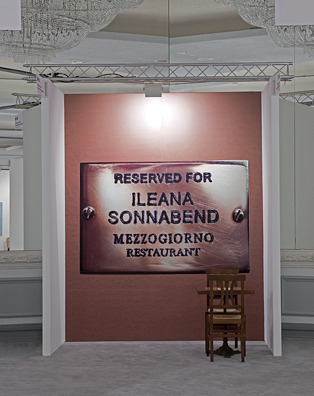Dikeou Superstars: Devon Dikeou

RESERVED FOR LEO CASTELLI: SINCE CEZANNE (After Clive Bell)
2010
Lateral View
Wall: C-Print Wall Mural of Name Plate Reserving a Table in Perpetuity for the Preeminent Art Dealer Leo Castelli
Floor: 2 Tables and 4 Chairs from the Restaurant Mezzogiorno
Photographed at Independent Art Fair in 2010
In 1951 Leo Castelli curated the groundbreaking Ninth Street Show that marked the emergence of Abstract Expressionism, thus beginning a new chapter in the history of art. Six years later he opened his eponymous gallery in New York City that continued this trend of showcasing revolutionary art from America and Europe. Dubbed “the godfather of the contemporary art world” by Dennis Hopper, it is arguable that Castelli would not have found himself in this position without the initial influence and ongoing support of his wife, partner, and friend, Ileana Sonnabend. Together, Leo and Ileana championed the avant-garde, the difficult, the misunderstood art of the 20th century and gave it the visibility and support it needed to succeed. Devon Dikeou created her installations Reserved for Leo Castelli and Reserved for Ileana Sonnabend as an homage to these important figures. Both are exhibited at Dikeou Collection and remind us that, in large part because of them, we are able to experience the complex and progressive dialogues put forth by the variety of contemporary artists represented in the collection.

RESERVED FOR ILEANA SONNABEND: “BUDDHA OR MACHIAVELLI”
(Brenda Richardson about Ileana Sonnabend as quoted by Calvin Tomkins— The New Yorker)
2010 Ongoing
Wall: C-Print of Name Plate Reserving a Table in Perpetuity for the Preeminent Art Dealer Ileana Sonnabend
Floor: 1 Table and 2 Chairs from the Restaurant Mezzogiorno
Photographed at NADA Miami Beach in 2010
Leo Castelli’s gallery moved around over the years and established multiple locations in Manhattan, predominantly centralized in the Upper East Side and SoHo. Though Leo and Ileana divorced in 1959, they remained close associates, and she started her own gallery near one of Leo’s SoHo outposts. Naturally, being in such close proximity, they shared space with one another amicably in both public and private realms. One of these spaces was Mezzogiorno, an Italian restaurant that specializes in Florentine fare where art dealers would wine and dine curators, artists, and collectors. Leo was at Mezzogiorno so often that he joked a table should be permanently reserved just for him, and so it happened. A brass plaque inscribed with “Reserved for Leo Castelli” and the name of the restaurant below was hung on the wall next to a four-top table. Later Ileana was given the same plaque, only her table sat just two, a nuanced jab at women’s status in the business of art. Upon seeing these plaques years later, Devon Dikeou immediately recognized their great symbolic value.
Dikeou’s art aims to define the spaces that act as interfaces between the artist, the context of viewing the art, and the collector. Her interest in the role of liminal spaces that serve as significant yet overlooked areas where important things occur, like major art exchanges at a small neighborhood restaurant, make the “Reserved” plaques the perfect subjects within her scope of practice. Dikeou photographed each of the plaques and printed them in two sizes – one to match the exact dimensions of the real plaque and mural-sized to fill an entire wall. The wall-sized murals are accompanied by dining sets from Mezzogiorno; a table for two for Ileana, and a table for four for Leo. Each of these installations were originally exhibited at art fairs, which Dikeou calls “the most fluid arena of art world market.” Today they exist at Dikeou Collection, another fluid environment but one where monetary exchange is absent, just like the dealers who are absent from their tables. The installation becomes a space where viewers can reflect on the tremendous influence these people had on the art world without overt reference to their wheelings and dealings. As Dikeou notes in her artist statement, “the plaques exist reserving a table in eternity for each art world deity, or perhaps their angels.”

Mezzogiorno has always taken pride in its status as a hub for artists and folks in the fashion and entertainment industries. Their website features an engaging gallery page with photos of their beloved patron, artist drawings, and press archives. Above is a clip from a cartoon published in a 1993 Vanity Fair article about the acclaimed eatery, with Ileana sharing a glass of wine with John Baldessari at her table for two, and Leo canoodling with Umberto Eco, Jasper Johns, and James Rosenquist.
-Hayley Richardson
